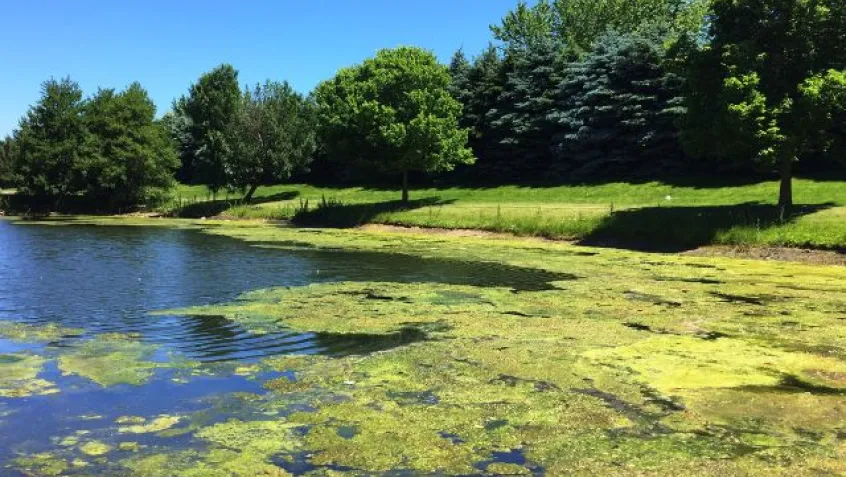
August is Water Quality Month, and it's crucial for all of us to understand the impact of harmful algal blooms on our local water bodies. These blooms can dramatically alter the color of the water—which is sometimes even visible from space—and produce an odor akin to rotting meat. It's vital to understand the origins of these public health threats and the steps we can take to prevent their occurrence in our communities, where they pose a significant health risk to plants, animals, and humans.
“Algae” is a broad term used by scientists and health experts to describe a variety of photosynthetic organisms that use sunlight, water, and carbon dioxide to produce oxygen and energy. Though some species of algae resemble plants, they lack traditional roots, stems, and leaves, putting them in a separate category of their own.
Even within this special grouping, there are many different types of algae—some can be smaller than 1/10th of the width of a human hair, while others will grow to be over 100 feet long!
Algae All Around Us
Though we often cannot see them, algae are all around us, inhabiting land, sea, and both fresh and brackish water. They are a fundamental component of the environment, forming the base of numerous food chains—a role they've played for eons.
Cyanobacteria, also known as blue-green algae, are the oldest known fossils on Earth, with a history dating back 3.5 billion years! They continue to thrive today, forming one of the largest groups of bacteria on the planet. You might recognize cyanobacteria as a common culprit behind harmful algal blooms.
These algal communities are a natural and essential part of the ecosystem. However, under certain conditions—warm water, abundant sunlight, and a high nutrient concentration in the water—their populations can explode. This overgrowth, often fueled by factors such as stormwater runoff, nutrient pollution, and excessive fertilizer use, results in what is known as an algal bloom.
Adverse Effects of Algae
Algal blooms, which can appear in various colors, pose significant health risks to humans and animals by polluting waterways and drinking resources. Cyanobacteria is the primary cause of toxic algal blooms in freshwater systems, producing cyanotoxins or poisons that can harm the liver, nervous system, respiratory system, and skin of those exposed to them.
Contact with contaminated water through drinking, bathing, or swimming can lead to a range of health issues, including blisters, fever, muscle and joint pain, paralysis, asthma, and allergic reactions such as rashes. In severe instances, toxic algal blooms have been linked to the deaths of wildlife and domestic animals.
Nutrient Pollution and Algae
Excessive levels of nitrogen and phosphorus, known as nutrient pollution, pose a significant environmental challenge. These elements are vital for the growth of plants and animals, but when their levels spike, the consequences can be harmful.
Nitrogen, which is naturally abundant, can infiltrate our water, land, and air through various sources such as chemical fertilizers, sewage, and fossil fuel combustion. When this excess nitrogen turns into nitrate in tap water, it can hinder the oxygen transport in the bloodstream of infants and young livestock.
Phosphorus, a mineral found in various foods, plays a crucial role in our body's functions. Phosphates, a chemical derivative of phosphorus, are often added to processed foods and cleaning products, not for their nutritional value, but to enhance the product's flavor or effectiveness. However, when phosphorous levels exceed the safe limit, it can be detrimental, especially for people suffering from kidney disease. It can cause bone loss and even lead to severe conditions like heart disease.
In aquatic ecosystems, the right balance of nitrogen and phosphorus is essential for the growth of algae and aquatic plants, which in turn provide food and habitat for fish and other organisms. However, an overabundance of these nutrients can trigger algal blooms, which lower the water's oxygen and pH levels. This leads to a process called eutrophication, which can be fatal for aquatic life.
Exercise Caution Around Algae
If you encounter a body of water with a red, green, or brown tint, or if the water has a thick, scum-like accumulation on the shoreline and surface and emits an unpleasant odor, remember these guidelines:
- Avoid contact with the water. Refrain from swimming, boating, or fishing in it, and keep children and pets at a safe distance.
- If you inadvertently come into contact with water you suspect is contaminated, rinse off immediately with clean, fresh water.
- Do not attempt to kill the algae with algaecides yourself. The process of killing the algae can burst its cells, potentially releasing more toxins into the water. Leave the eradication of algae to the professionals.
- If you think someone has been poisoned by a toxic algal bloom, seek medical attention immediately.
- Report algal blooms to your state's department of health or environment. They can then relay your report to the Centers for Disease Control and Prevention (CDC)’s new national reporting system, the One Health Harmful Algal Bloom System.
The everyday actions you take at home and in your community can significantly influence water quality—for better or worse! To learn more about how harmful algal blooms can be unintentionally created and maintained, check out our online course, the Watershed Sleuth Challenge.
What You Can Do to Reduce Algal Blooms
Here are some practical steps you can take in your everyday life to combat nutrient pollution and contribute to a healthier environment:
- Opt for phosphate-free detergents, soaps, and household cleaners. Run your washing machines only when you have a full load, and use the appropriate amount of detergent. Avoid phosphates and other harmful ingredients in cleaning products by looking for the Safer Choice label.
- Always clean up after your pet and avoid walking them near waterways. Encourage other pet owners to do the same.
- Regularly inspect and pump out your septic system. Avoid using septic system additives and diverting storm drains or basement pumps into septic systems.
- Install low-flow faucets, shower heads, and water-saving appliances. Repair leaking faucets, toilets, and pumps.
- Reduce electricity usage by turning off or unplugging devices when not in use, adjusting the thermostat, and replacing old light bulbs with energy-efficient ones.
- Use commercial car washes or wash your car at home on a pervious surface with nontoxic, phosphate-free soaps. Plan your errands to reduce driving, carpool, use public transportation, or consider alternative travel methods like biking or walking.
Download Algae Bloom Infographic



